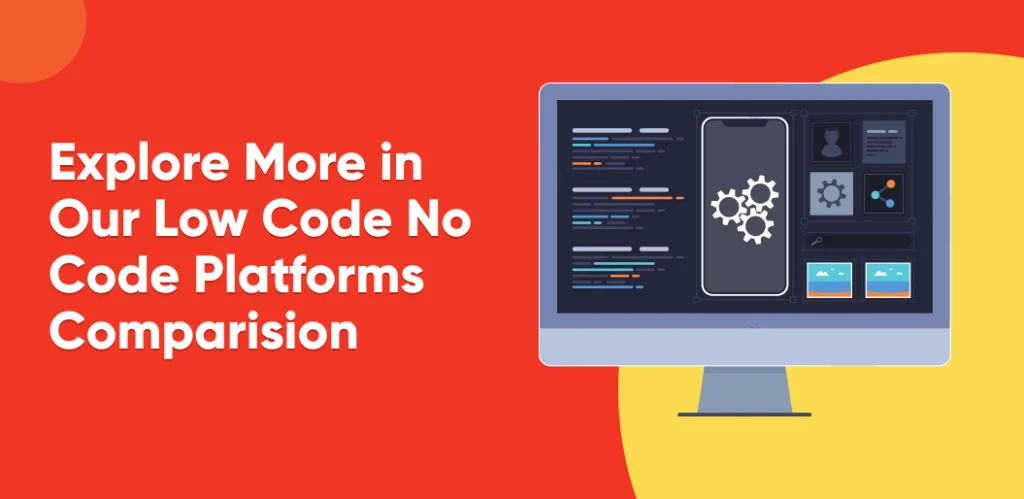For all of time, the only way for enterprises to drive business outcomes with software was to buy off-the-shelf software solutions or tackle custom software development in-house or outsourced. Today’s low code and no code solutions have changed how applications are being developed — and by whom.
What is the low-code no-code movement?
Faced with persistent IT staff shortages, budget pressures, and the need for accelerated development velocity, organizations and development teams of all sizes are turning to low code and no code app development — technology platforms that help accelerate software development by as much as 10 times. Gartner estimates that this demand will fuel the growth of low code development technologies by 20% in 2023. The agile development techniques of no-code and low-code development can be “rocket fuel” for the digital business, say Forrester analysts.
Low Code No Code Definition
What is low code no code, and how do the two terms differ?
What is No Code?
A no code software development (no-code) platform combines an intuitive interface and drag-and-drop functionality to help develop applications from various templates and components of pre-programmed software. This way, anyone (software developer or business user) can create an application without coding.
What is Low Code?
Low code software development (low-code) uses a platform requiring minimal coding to create software. Like with no code, low code development is intuitive with handy tools and functionality. However, the key “low code vs. no code” difference is the ability to augment or personalize the application with customizations done with code. Low code is considered a way to “bootstrap” development by speeding up more rote parts of the development process — also known as “Rapid Application Development.”
Who Are The Target Users of Low-Code and No-Code Development?
A wide variety of users uses both low code and no code development. Originally intended to appeal to users without extensive coding knowledge — junior developers and business users — the platforms also appeal to software developers to speed up custom development or prototype an idea.
- Business users & non-technical professionals love the ability to test ideas and/or build applications without costly development or specialized skills.
- Citizen developers (non-programmers) are a growing asset in many organizations. They are encouraged to help get non-IT employees to create valuable business applications that improve processes and boost innovation.
- IT professionals can speed up development on simple applications and/or use the platforms to prototype an idea as part of a comprehensive product development process.
- Educators must leverage low and no code solutions to develop applications in days or weeks (not months) to meet organizational and in-class demands. For example, one school principal built a reading assessment tool, while other ideas can be
- Freelancers and Consultants may have valuable experience in business, UX design, or other technical skills, helping fill an IT skill gap with valuable app services.
“The democratization of development is not a fad or the naive fantasy of industry talking heads — it is serious business and represents the future of enterprise technology work.”
What Can I Build Using Low Code No Code?
There is no ‘finite’ definition of what can be built with low code no code platforms. Depending on the flexibility and extensibility of the platform, you can build any kind of app. However, low code no code development platforms do focus on key digital products with the specialized templates, libraries, and tools to build:
- Interactive apps of any kind! Want to bring a textbook to life, replace a spreadsheet, engage with customers, or support collaboration? Take an idea and bring it to life.
- eCommerce applications and marketplaces. Many leading eCommerce platforms offer template and no-code components to kick-start your eCommerce app.
- CRM Systems Read our ultimate guide to customer relationship management for more insight.
- Content Management Systems (CMS) are often, by default, low or no code solutions to build websites leveraging templates, components, and infrastructure all built together. Many CMS platforms are becoming headless and low code / no code.
- Project Management tools help create tactical apps that serve a simple function, often based on aggregating multiple data sources, and assist in streamlining workflows.
- Better data insights by bridging data from multiple sources and more customizable reports and data visualizations
- Social apps that meet specific enterprise needs
- Online forms and surveys to create branded engagement tools for stakeholders
- IoT Applications and systems with specific IoT low code platforms (e.g., AppMaster) that offer specific features needed in IoT, such as sensor data collection, device management, security, and more.
- Prototyping and MVPs can be built to support any product development lifecycle, helping quickly test ideas.
Benefits of Low Code No Code
Low code no code development platforms are designed to be easy to use. Many offer specialized templates and components for specific needs (e.g., CMS or IoT apps). They provide myriad benefits for creating apps or streamlining application development so that ‘easy’ and less complex elements are achieved at record time, freeing up development time for more complex tasks and innovation.
The full benefits of low code no code are:
- Accelerated application development
- Increased productivity
- Cost efficiency
- Empowerment of citizen developers
- Rapid prototyping and iteration
- Agility and flexibility
- Reduced IT backlog
- Enhanced collaboration
- Scalability and extensibility
- Promotion of innovation and agility
- Reduced maintenance overhead
- Accessibility and inclusivity
- Built-in security (but still vet it to follow best practices)
When Does Low Code No Code Development Work - And When Does It Not?
Low code no code application development has opened up doors for more agile responses to business needs, but there are better approaches for software development.
Ideal Use Cases for Low Code No Code
Low code no code development services are best suited for situations that merit a simple app, require rapid development, or have other constraints (skill, time, budget).
- Rapid prototyping
- Simple applications
- Business process automation / task efficiency
- Citizen development of custom apps or features
- Time and cost constraints
In addition to the above, there is also a growing use of “citizen developers” as an enterprise strategy, encouraging non-IT users to create usable, long-term products to increase efficiency or drive business growth. Such a program involves mentorship, governance, and support.
Governance best practices for low code no code development
Empowering development with low code no code tools can help reduce time to market with new ideas. However, every low code no code development use should be governed by IT to reduce application sprawl and ensure oversight over security. Best practices include:
- Establish clear policies and standards over what tools can be used and for what purpose. Ideally, embed any specific guardrails within the tool.
- Support with user training and mentorship
- Include oversight for security, compliance, and quality
- Create a formal pipeline for idea review & deployment if beyond the scope of personal use
Where Low Code No Code Development Does Not Work
The question of the suitability of low code no code app development often arises. Often, one concern is “Will low-code no-code replace developers?” and the answer is no. There are many key instances where this light style of low code no code development is not appropriate – and should not be used, including:
- Complex functionality
- Unstructured workflows
- Performance and scalability
- Unique or niche requirements
- Deep Integrations with internal enterprise systems or third-party systems
- Complete control and customization are required
- Strict compliance requirements (e.g., federal space)
Overall, no code will specifically not support any need for customization. Still, many challenges with low code can be overcome by choosing the right platform, as each offers specialized templates, components, features, and integrations. When evaluating options, have a clear idea of the desired business outcome and/or user stories to help understand what the ideal end-state application will need to do.
Caveat: While low code no code platforms are not ideal for complex or niche applications in their entirety, they can be used to bootstrap early development and/or prototype development.
Top Low Code No Code Development Platforms
While there may be familiarity with top platforms such as Bubble (no code) and Power Apps (low code), there are, in fact, over 100 low code and no code platforms available today as vendors step in to meet the demand for new development tools and greater participation from business users.
Low Code Platforms
- Microsoft Power Apps Recognized by Gartner as a leader in enterprise low-code platforms, Power Apps offers support to build websites, web applications, mobile apps, and chatbots (the latter as no-code) by connecting with the broader Microsoft ecosystem. Offers tailored AI models for automation (team, process, and UI flows and insights), extensive integrations, quick deployment, and extensibility.
- OutSystems Another Gartner-recognized leader in enterprise low-code platforms, OutSystems, focuses on creating web applications and mobile apps that are high-performance, scalable, and with a great user experience—a leading choice for enterprises undertaking legacy application modernization. Apps can be deployed to cloud or on-premise.
- Mendix Also, a Gartner-leading low-code platform, Mendix supports enterprise app development, cross-platform mobile development, legacy application modernization, and process automation. Mendix focuses on securely integrating data and logic from external sources and legacy systems. Includes strong developer tools for version control, testing, and deployment.
- Retool Retool is ideal for creating enterprise tools such as admin dashboards, database interfaces, custom reports, etc. Integrates with various APIs and databases to help connect with enterprise systems.
- Appian Appian is known for AI process automation, process mining, and data-based applications.
- FileMaker FileMaker supports web and mobile app development with an intuitive UI and template library and an extensive partner network.
- Zoho Creator Zoho Creator specializes in cross-platform mobile apps. With over 550 integrations, Zoho supports process automation and offers real-time, conversational analytics and AI capabilities.
- Salesforce Lightning Salesforce is a recognized leader in its enterprise CRM. Salesforce Lightning is a no-code / low-code to help build custom applications (based on CRM data) and complex workflows (via its Process Builder).
- Flutter Flow Flutter Flow specializes in cross-platform mobile and web apps and is known for its ability to build a very custom and interactive UI.
- ServiceNow App Engine AppEngine by ServiceNow is an enterprise platform to create internal and external apps that meet strict standards and guardrails (including those for federal agencies), deeply integrated with ServiceNow data and workflows.
No Code Platforms
- Bubble Bubble is one of the most popular platforms, with many helpful tutorials. Design to help create web applications and websites with its dynamic, engaging templates and scalable infrastructure. High level of intuitive, visual development elements. Powered by Amazon Web Services with strong security & SEO.
- Jotform Jotform is designed to help make tables, forms, and databases with many helpful libraries and templates.
- Google AppSheet AppSheet connects to the Google ecosystem and beyond to make it easier to develop web applications.
- Strikingly Explicitly known for building websites, Strikingly is very user-friendly, with extensive templates and elements, built-in analytics, and optimization tools. Includes options to create newsletters, sign-up forms, and live chat.
- Creatio Creatio is designed to support web apps, process automation, and CRM, strongly focusing on automating workflows and supporting process-heavy industries such as banking and manufacturing.
- Adalo Adalo is a favorite among UX designers and those with a visual flair but is more suited to those with some experience in app design.
- Glide Glide is considered by many to be one of the easiest no-code platforms to use and known to create strikingly designed apps.
No Code Low Code Use Cases
What are some real-world use cases for low code no code development?
- Shell Shell has created a citizen development strategy that budgets for and nurtures ideas through boot camps, hackathons, training, and support. In one example, an engineer developed an application to help manage maintenance procedures using Microsoft Power Apps.
- Western Union Western Union believes agility and innovation are core to its future
success. Looking to improve its digital experiences, it leveraged OutSystems across its whole stack – front-end,
integration, and back-end – including its new digital banking app that is used in over 300 countries, meets
strict compliance requirements, and integrates with third parties.
“On an earlier project, we had ten people working on a pricing and UX project. It took six months to do the bare minimum. We recently delivered a similar requirement to a higher standard using one OutSystems developer in just 15 days.”
— Tom Mazzaferro, Chief Data and Innovation Officer, Western Union.
Future of Low Code No Code Development
When it comes to the impact of low code no code platforms on the software industry, common questions include: Is no code profitable? And Is low code no code the future? Gartner predicts that by 2026, developers outside formal IT departments will account for at least 80% of the user base for low-code development tools, with results that are streamlining processes, reducing development effort, lowering cost (from 24% to 66%, depending on the case study!) and increasing innovation overall — delivering more apps, and a streamlined pipeline of updates, at a faster pace.
As organizations continue digitally transforming, they need to do more with less, making low code, no code an ideal solution. The future of low code no code development includes a greater use of artificial intelligence to improve app and app development processes.
Low Code No Code Development with Net Solutions
While it is true that low code and no code platforms can help bootstrap your product development, it’s not always clear when to use this approach or how to choose the right platform to support both short and long-term business goals. Forrester recommends hiring low code developers with valid certifications, working on teams of IT and non-IT employees (e.g., design, business analyst), and having the business expertise to gather requirements, lead projects, and test the work.
Net Solutions experienced developers, designers, and analysts know how to choose and utilize low-code platforms to design and build high-performing apps in record time, including all the benefits of low-code, including cost savings, faster releases, improved security, and more.
Frequently Asked Questions
1.What is the difference between low code and no code?
Both platforms focus on simple interfaces to build applications, but only low code allows for custom code to be used.
2. Is low code no code development suitable for large-scale and enterprise-level projects?
Each project should be detailed to determine requirements and complexity to help choose the appropriate low code no code platform. While low code no code development can accelerate some aspects of development, the more complex the product requirements, the less likely it will be a good fit. Good governance is also key to enterprise use of low code no code development.
3.Can low code no code applications be customized and extended with additional code?
Most low code applications can be customized and extended depending on the platform to incorporate more specific capabilities. Carefully examine API support, extensibility, and potential lock-in to ensure you choose the right platform.
4. How does low code no code development support collaboration among team members?
IT and non-IT team members can understand the simple visual interfaces of no code low code tools, making participating in application development and sharing ideas easier. Some low code and no code tools support versioning and collaboration (but not all) to support IT team collaboration.


